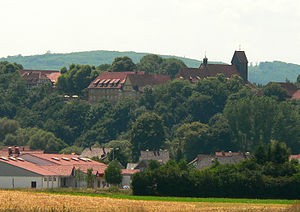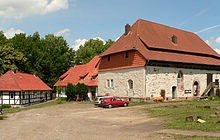Katlenburg Castle

The Katlenburg is a former castle and monastery facility in the districtl Katlenburg in the community Katlenburg-Lindau in Lower Saxony. The in the 11th-century as Sporn castle built facility with its changeable history was for the longest time monastery and seat of an agricultural domain, late an educational institution. Since 1990 the facility is known as book castle.
The Katlen castle is situated near the village Katlenburg in the western Harz foreland. It's located in a strategic favourable place at the end of a spur, the Katelberg, name giver of the castle. The rivers Rhume and Katlenbach flow on both sides of the castle. There are altogether 4 river and beck course in the lowland. The former bog lowland impeded enemy advances. They are the Rhume with two arms, the Söse and the Katlenbach. Advancement towards the castle was only possible without bigger obstructions via the mountain in the south. In the Middle Ages the Nordhäuser military road ran below the castle on a flat to Leipzig, which lead the traffic from the Rhineland to Thuringia. The road crossed the Rhume directly below the castle.

The castle originated in the 11th-century by the earls of Katlenburg, who had at that time national importance in the Reich's politics. The earl dynasty can be traced to 1002 by the brothers Heinrich and Udo von Katlenburg. Their descenders were Dietrich I., Dietrich II. and Dietrich III. The pious and childless earl Dietrich III and his wife Adela von Beichlingen converted the castle into a monastery by lowering the ring wall in 1105. The monastery was donated in honour of the evangelist Johannes and named Johannes monastery. Whether the devoutness or childlessness were the motive behind the monastery founding is not totally clear. Another reason might be the relocation of the sovereignty centre to Stauffen castle near Gittelde, where earl Dietrich also had his own coins minted. The count and countess constructed the minster of the Katlen castle. his dynasty ended with his death during the siege of Cologne in 1106. He buried on the crypt of the by him constructed church. In the 12th-century Augustine friars lived in the monastery first later also Augustine-nuns.
In the 14th-century the monastery suffered a few bad strokes of fate. In 1346 the monastery burned down, arson was suspected. This fire was mentioned in the Catlenburger song from 1346, which is considered the oldest Lower Saxon song. In 1348 the plague raged in the area, which hampered the monastery's economical situation. In 1392 an assault came from Thuringia.

